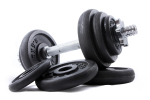|
2006/07/13, 06:13 AM
Dont know if this has been discussed here before but a couple months ago George Brooks of UC Berkley definitively proved that lactic acid produced by the body is fuel that is used by the muscles.....not waste byproduct as was previously believed by many people....
http://www.nytimes.com/2006/05/16/health/nutrition/16run.html?ex=1305432000&en=2778e99d7eab85a6&ei=5090&partner=rssuserland&emc=rss
http://www.physorg.com/news64680736.html
|
|
|
|
2006/07/13, 09:31 AM
Very interesting....thanks for the post menace.
|
|
2006/07/13, 12:22 PM
This function must be the reason why doing an aerobic activity after an anerobic activity improves fat oxidation.
Awesome article... The human body will never cease to amaze me.
--------------
Michael
Powerlifters -
We eat raw meat, and sleep naked in the snow...
|
|
2006/07/13, 09:53 PM
That might be worth the effort to see if we can get permission to post that as a thumb tack even though nobody reads them. Changed my perspective.
|
|
2006/07/14, 03:58 AM
Yea...this should probably be made a sticky....whether people read it or not is up to them.....but it's definitely a great article.....
|
|
2006/07/19, 11:10 PM
bump
|
|
2006/08/02, 07:35 PM
One good way to think of it is LT(lactic threshold) as the highest intensity you can maintain without fatigue; LT is a pretty challenging intensity. 90% of LT is doable and some believe that working in that range gives the optimal endurance adaptations.
--------------
Maximus from Gladiator....Strength and Honor!
|
|
2006/08/02, 07:38 PM
Here is an interesting study(notice the date, brand new) comparing working out in that range. Even more fascinating is the comparison of "weekend warrior" as compared to 5 days per week in training adaptations. Seems either will work the same. Of course the flaw in the study is no weight training was done, this would be interesting to see the comparison.
Meyer T Does cumulating endurance training at the weekends impair training effectiveness? Eur J Cardiovasc Prev Rehabil. 2006 Aug;13(4):578-84.
BACKGROUND: Due to occupational restrictions many people's recreational endurance activities are confined to the weekends. We intended to clarify if cumulating the training load in such a way diminishes endurance gains. DESIGN: We conducted a longitudinal study comparing training-induced changes within three independent samples. METHODS: Thirty-eight healthy untrained participants (45+/-8 years, 80+/-18 kg; 172+/-9 cm) were stratified for endurance capacity and sex and randomly assigned to three groups: 'weekend warrior' (n=13, two sessions per week on consecutive days, 75 min each, intensity 90% of the anaerobic threshold; baseline lactate+1.5 mmol/l), regular training (n=12, five sessions per week, 30 min each, same intensity as weekend warrior), and control (n=13, no training). Training was conducted over 12 weeks and monitored by means of heart rate. Identical graded treadmill protocols before and after the training program served for exercise prescription and assessment of endurance effects. RESULTS: VO2max improved similarly in weekend warrior (+3.4 ml/min per kg) and register training (+1.5 ml/min per kg; P=0.20 between groups). Compared with controls (-1.0 ml/min per kg) this effect was significant for weekend warriors (P<0.01) whereas there was only a tendency for the regular training group (P=0.10). In comparison with controls (mean decrease, 3 beats/min), the average heart rate during exercise decreased significantly by 11 beats/min (weekend warriors, P<0.01) and 9 beats/min (regular training, P<0.05). There was no significant difference, however, between the weekend warrior and regular training groups (P=0.99). CONCLUSION: In a middle-aged population of healthy untrained subjects, cumulating the training load at the weekends does not lead to an impairment of endurance gains in comparison with a smoother training distribution.
--------------
Maximus from Gladiator....Strength and Honor!
|





